Raabe J. Hydro power - the design, use, and function of hydromechanical, hydraulic, and electrical еquipment
Подождите немного. Документ загружается.


11.3.4.3. Intervention of penstock
with the related deviation of flow
q
=
A
Q/Q,
=
A
clc,,
and head
h
=
A
HIH
(Q,
=
rated
flow,
H
=
rated head,
c,
=
rated pipe velocity) the coordinate
[
=
,-/L
along tlie pipe
beginning at the upper end, and
assuming a vanishingly small velocity in the pipe,
the equation of onedimensional motion in the z-direction and the continuity of a fluid
element filling the pipe section read (see
Cap.
8.2)
\
dh/ac
+
T,, aq/at
=
0, and (1 1.3- 18)
in
which T,, is the start up time of the penstock, T,,
=
c,
L/(gH) from (1 1.2- 14), L the
length,
H
the head,
TL
=
Lla the travel time of a pressure wave, to cover the
length
L
with the velocity a, and
K
the following penstock parameter,
being the ratio of pressure surge due to water hammer, induced by cutting off the speed
cN,
to the pressure of the rated head
H.
11.3.4.4. Boundary conditions of water hammer in
a
simple
pipe
For
the two governing equations due to water hammer (11.3- 18) and (11.3- 19), the
following solution is introduced
h
=
hf e"eP' (11.3-21) and
q
-
qf e':eP', (1 1.3
-
22)
in
which hf and q: are unknown amplitudes. Inserting the last two relations into the
equation of motion and continuity gives
rhf
+
T,,pqf
=
0, phf
+
(Kr/TL)
qf
=
0.
(1 1.3-23)
By
Crarner's rule, the interesting case h:
=l=
0, 9:
=I=
0 requires
With the complete solution of
(11.3-18), (11.3- 19)
/
h
=
til
ePT~Ce~'
+
~,~-PTLS~P'
g
=
q1
ePT~Ce~'
+
q2e-PT~CeP'
the
iinknown constants follow from the boundary conditions.
At
the upper end of the penstock
([
=
0): h(c
=
0)
=
0. Hence h,
=
-
h,,
Due to the constancy of pressure at the upper end, a.h/at vanishes at
I:
=
0. Hence fram
(11.3-
19): q,
=
9,. Hence (11.3-26)
q
=
29, eP' coshp
TL[.
(1 1.3-28)
Putting
Ir
and q from (1 1.3-28), (1 1.3-27)
in
(1 1.3- 18) gives

/I,/C/:
=
-
..p
1.1'
L
-
-
-
K.
(1
l.j-29,
Eqs.
(
1
1.3
--
27)
and
(
1
1.3
--
28)
give thc dcsired rclatiun bctf.veell relative surgt: or
prcssurr!
hcacl
11
and
rclntivc
incrcrnciit of flow
(I
on tllc tiirbillc's cnd of penstock
((
=
1)
,,
11.3.4.5.
re la ti or^
for the co~~trolled
system
To
bbtnin
the
dcsircd rcl;~tion
R(s,
nr),
q
in the last equation has
to
bc expressed
in
tern
of
tn
;
and
r.
With thc
load
dezrce
1,
=
P,/lj,,
the
efliciency parameter
Kv
=
(i?,,,-efficiency at rated load), and the similarity law
'Lvlq
Q
=
Q
I
,
(n,
I?])
D2
(Y
lI)'l2,
(11.3-31)
the follo\ving approxirnatiorl for infinitesimally small
A
Q,
q=
AQ/Q,
=
i.K,dQ/Q .rt:lLK,dQ/Q
=
I.K,dlnQ
(11.3-32)
=
iK,
d
In[Q,,(n, tn)
LiL(g~)1i2]
=
RKv[dQ,,/Ql,
+
(112) dHlfl]
=
j-K,[(n,lQl
1)
(aQ1
ll~n),,,~l~ln,
+
(mdQ
11)
(ZQ
1
ll~?l)n~rtl/~~l.,
+
~HI~HJ,
the approximations
(111
=
A
n,
dm
=
Am,
(11-1
=
A
H
and
fit
-
A
mltn,,,
11
=
AHIH,
and
(11.3---
i3),
the following intermediate result
q(x,
h)
is
obtained
Putting tE.is relation into (1
1.3-30)
gives
the
desired relation
Il(nt,
x)
/I
=
-
[iXqK(KQnx
+
KQmttl)
ta~?hpT,]/[l
+
(K
KqR/2) tal~hIpqj].
(I
1.3-34)
From
(1
i.3-
17)
E1nn;in;tting
11
in the liist two relations gives
the
desircd
m(s)
relation of
the
controlled
systerrl, co~sisti~?~ of turbine
(KQn, KQ,l,, K,,
/.),
penstock
(7;.,
K)
and
grid(K,),
as
(2/3)
[(T,/i.j
.t
-
(K,,
+
KQn,) tn
+
K,x]
[l
+
(A
K, K/2)
tanhb
TL)]
=
-
i.K K,(KQnx
+
K,,,m)
tanh(p
c).
(11.3-36)
11.3.5.
Relation
for
closed
control
loop,
stability parameters
Eliminating and its derivative from
(1
1.3-36)
and
(1
1.3-5)
gives the differential equa-
tion for the
closed
loop
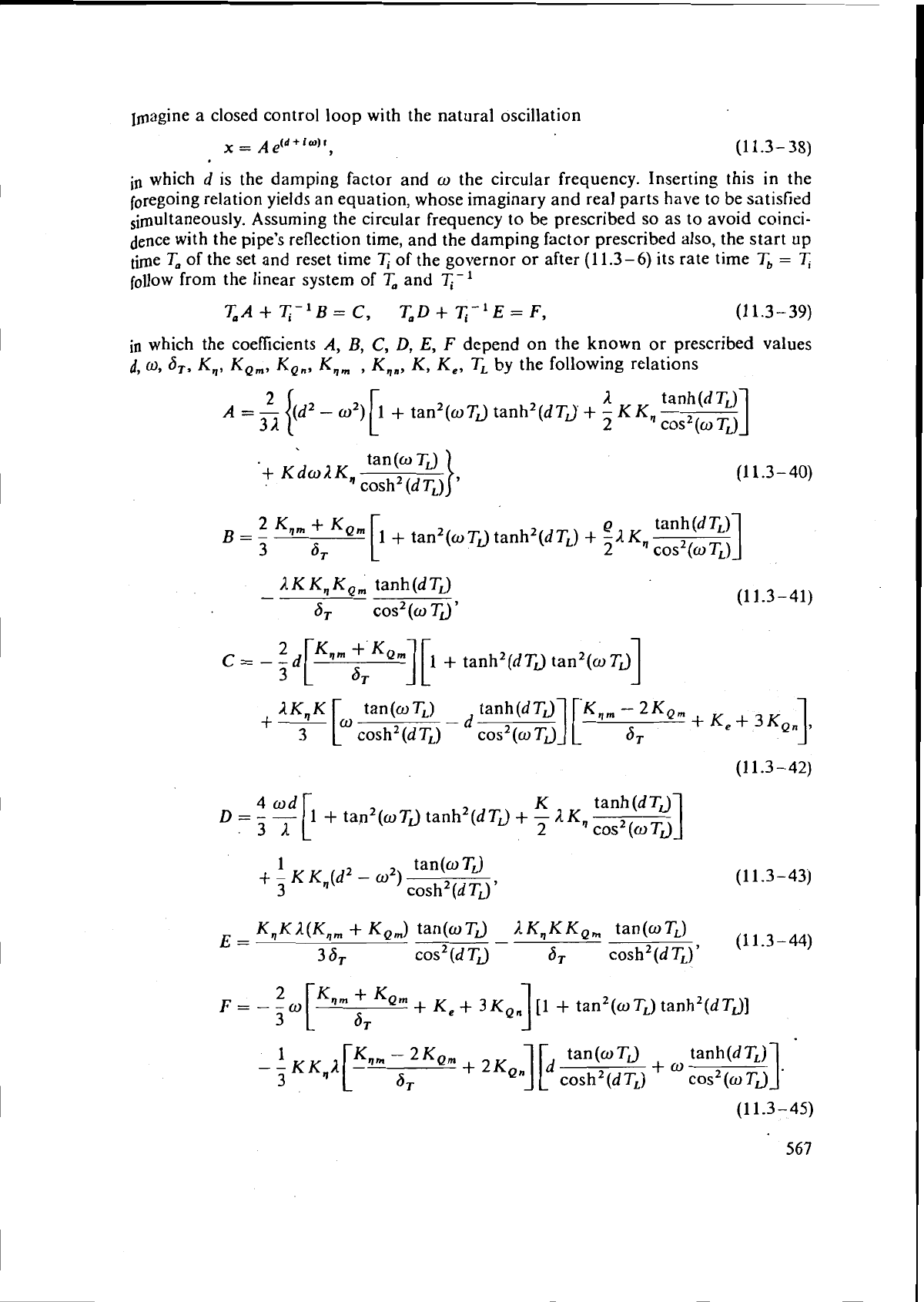
~~agine a closed control loop with the natural oscillation
X
=
Ae(d+iO)t
9
(1 1.3-
35)
in
which
d
is the damping factor and
o
the circular frequency. Inserting this in the
foregoing relation yields an equation, whose imaginary and real parts have to be satisfied
Assuming the circular frequency to be prescribed so as to avoid coinci-
dence with the pipe's reflection time, and the damping factor prescribed also, the start up
time
T,
of the set and reset time
7;
of the governor or after (1 1.3-6) its rate time
T,
=
7;
foilow from the linear system of
T,
and
ql'-
in
which the coefficients A,
B,
C,
D,
E,
F
depend on the known or prescribed values
d,
o,
aT, K,, KQm, KQ,, K,,
,
K,,, K, Ke,
TL
by the following relations
2
13.
tanh
(d
TL)
A
=
-
{(d2
-
co2)
[I
+
tm2(wTJ tanh2(dTJ
+
-
KK,
31
2
COS~(O
TL)
I
tan (w TL)
+
KdoRK,
cos
h
(d
TL)
-
KK,A[-Kqm
-
2K~m
+
2KQ,]
[d
tan (w
TJ
+o
tanh(d TL)
3
6, cosh2(dTL) cos2(wTJ
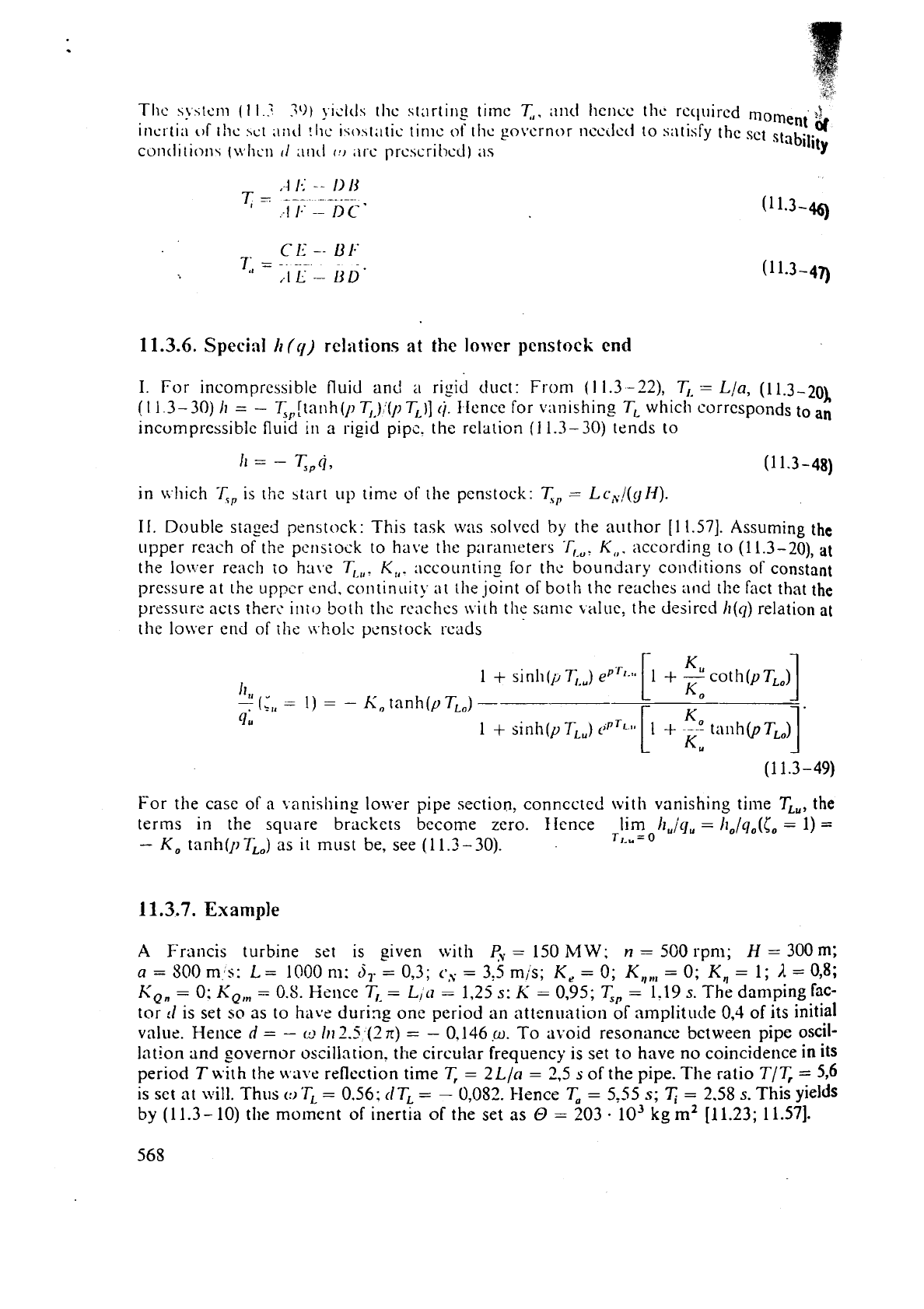
.
\
1
I
(1
I.
30)
!i;lcls ilic si:lrtin$ time
T,.
il~ld
I~CI~CC
tll~
rcquircd
momenl
incrti:~
(,I
ihc
hct
:lil~I
!tic isosiiltic tirlic
ol'
111c
governor
ncc~lcd
to s;\tisfy thc set
Nabililr
contlitio~ls (u~Iic.11
tl
:11lrl
(!I
;ire
prt'scril~ccl)
;IS
11.3.6.
Speci:ll
lt(q)
reliltions
at
the lower
pcnstock
end
I.
For
incompressible
fluid and
a
ripid duct:
From
(1
1.3
-22),
T,
=
Lla,
(1
1.3-20,
(1
1.3-30)
h
=
-
T,,(tnnh(l~
T,)'(JIT,)]
(j.
IIence for vanishing
TL
wwhh corrcspol~ds
to
an
incumprcssiblc flu~d
it1
a rigid pipz: the relation
(1
1.3-30) tends to
!I=-T
SP
cj
y
(11.3-48)
in
~vhich
T,,
is the btnrt
up
time of the penstock:
T,,
=
Lc,!(gN).
11.
Double staged penstock:
This
task
was solvccl
by
the author
[l
1.571.
Assuming
the
lipper reach of the penstock to
have
the parameters
T,-,.
K,,.
according to
(11.3-20),
at
the lo\!.er reach to ha1.e
T,,,.
K,,.
accounting for the boundary conditions of constant
pressure at the
uppcr
end,
contin~~itj at the joint of both rhc reaches and tl:e fact that
the
pressure acts thew illto both
thc
reaches
~virh
tile samc \alile: the desired
h(q)
relation
at
the lo\ver end of tllc ~vholz penstock reads
For the case of a 1;anishing lo~ser pipe section, conncctec! with vanishing time
TL,,
the
terms in the square brackets become zero.
Ifcnce
lim
Il,jq,
=
h,/q,(C,
=
1)
=
-
KO
tanh(pTL0) as
it
must
be,
see
(11.3-30).
TI-,.
=
0
1
1.3.7.
Example
A
Francis turbine set is given wit11
Pv
=
150
MW;
n
=
500
rpm;
H
=
300
m;
a
=
YO0
mls:
L=
1000
m:
ti,.
=
0,3;
rs,
=
3,5
mis;
K,
=
0;
K,,,
=
0;
K,
=
1;
A
=
03;
K,,
=
0;
K
,,,
=
0.8.
Hence
T,
=
L,cl
=
1,25
s:
K
=
0,95;
T,,,
=
1.19
s.
The
damping fac-
tor
:I
is set
so
as to
have
during one period an attcni~ntion of amplitude
O,4
of its initial
value. l-Ience
d
=
-
cc
1112.5
.(Z
n)
=
-
0.146
.a.
To avoid resonance between pipe
OSC~I-
lation and governor osciliation. the circular frequency is set
to
have no coincidence
in
its
period
T
with the
wa\.t:
reflection time
T,
=
2Lln
=
2-5
s
of
the
pipe. The ratio
TIT,
=
5,6
is
set at
will.
Thus
(:I
TL
=
0.56;
tlT'
=
-
0,052.
Hence
T,
=
535
s;
=
2.58
s.
This
yields
by
(11.3- 10)
the moment of inertia of the set
as
O
=
203
.
lo3
kgm2
[11.23;
11.573.
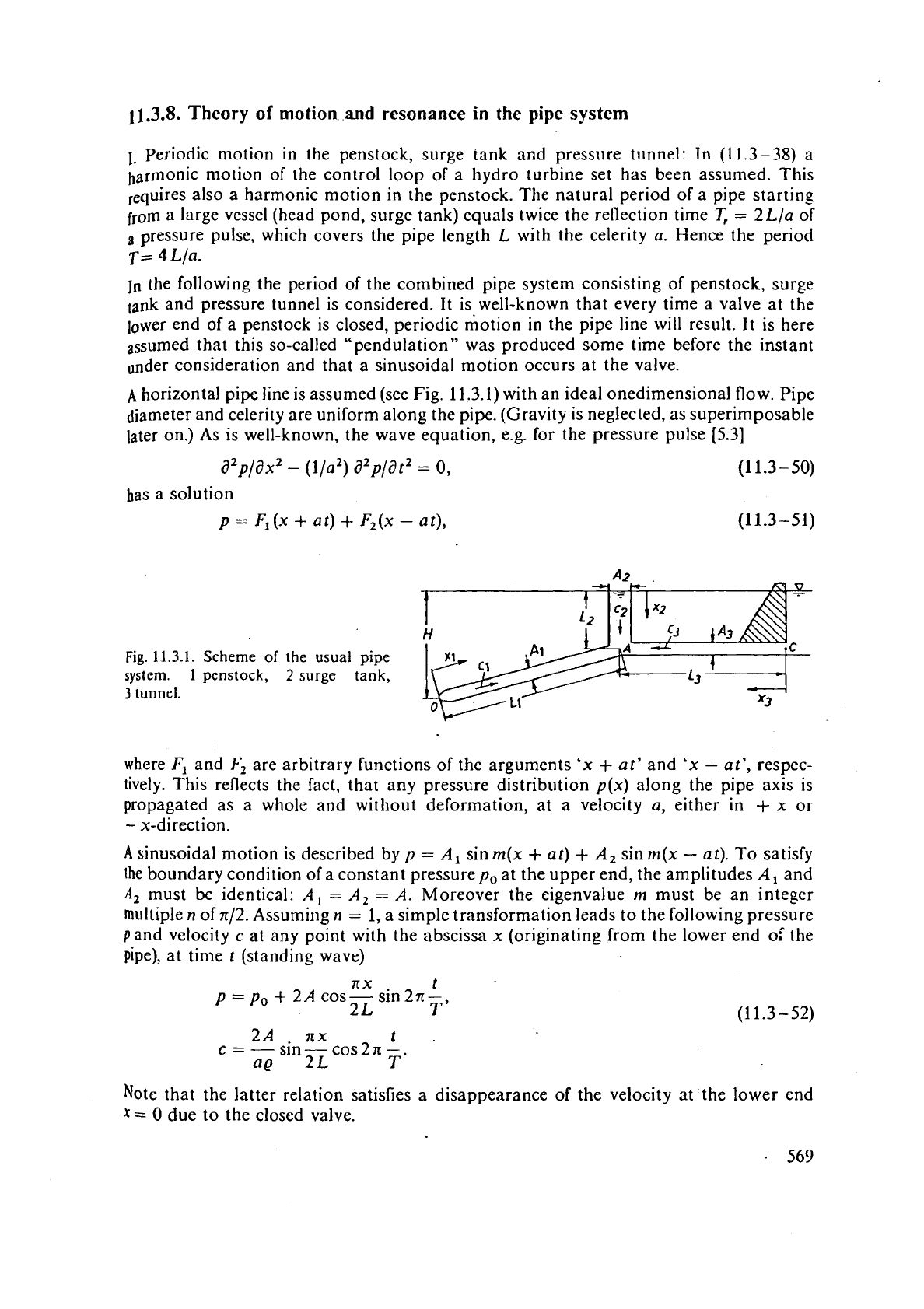
11.3.8.
Theory
of
motion
and
resonance in the pipe system
1.
Periodic motion in the penstock, surge tank and pressure tunnel: In
(1
1.3-38)
a
harmonic motion of the control loop of a hydro turbine set has been assumed. This
also a harmonic motion in the penstock. The natural period of a pipe
startins
from
a large vessel (head pond, surge tank) equals twice the reflection time
T,
=
2
Lla of
a
pressure pulse, which covers the pipe length L with the celerity a. Hence the period
T=
4 Lla.
In
the following the period of the combined pipe system consisting of penstock, surge
tank and pressure tunnel is considered. It is well-known that every time a valve at the
lower end of
a
penstock is closed, periodic motion in the pipe line will result. It is here
assumed that this so-called "pendulation" was produced some time before the instant
under consideration and that a sinusoidal motion occurs at the valve.
A
horizontal pipe line is assumed (see Fig. 11.3.1) with an ideal onedimensional flow. Pipe
diameter and celerity are uniform along the pipe. (Gravity is neglected, as
superimposable
later on.) As is well-known, the wave equation, e.g. for the pressure pulse
[5.3]
bas a solution
p
=
F,(x
+
at)
+
F,(x
-at),
Fig.
11.3.1.
Scheme of the usual pipe
system.
1
penstock,
2
surge
tank,
3
tunnel.
I
x3
where
I;;
and
F2
are arbitrary functions of the arguments
'x
+
at' and 'x
-
at', respec-
lively. This reflects the fact, that any pressure distribution p(x) along the pipe axis is
propagated as a
whole and without deformation, at a velocity a, either in
+
x
or
-
x-direction.
A
sinusoidal motion is described by
p
=
A,
sin
m(x
+
at)
+
A,
sin nr(x
-
at). To satisfy
!he
boundary condition of a constant pressurep, at the upper end, the amplitudes
A,
and
A,
must be identical:
A,
=
A,
=
A.
Moreover the eigenvalue
m
must be an integer
multiple
n
of
n/2.
Assuming
n
=
1, a simple transformation leads to the following pressure
P
and velocity
c
at any point with the abscissa x (originating from the lower end of the
pipe), at time
t
(standing wave)
7tX
t
p
=
p,
+
2A
cos- sin
2n-
2L
T'
Note that the latter relation satisfies a disappearance of the velocity at the lower end
x
=
0
due
to
the closed valve.

Mure
gencrnlly,
with
171
=
2x/T
as
thc cyclic frcqucncy of thc oscillation, pressure
'
belocity
rcud
as follows
and
x
p
=
p,
+
2A
COSIII
-
sinint,
a
The most important case to be examined is the resonance occurring in
a
system
of
pipe
lines. The discussion will be illustrated assuming a system of three pipe lines, joining
at
point
A
(Fig.
11.3.1).
The valve is supposed to be located at point
0,
at the bottom
of
pipe
1
(the penstock). Pipes
2
and 3 are open at their upper ends. where waves are totally
rcflectcd with change of sign. Such a system would represent a conventional arrangement
of pressure tunnel (pipe
3),
surge tank (pipe
2)
and pressure pipe or penstock (pipe
1)
in
a hydropower station.
The iheoretical period of pipe
1,
length
L,,
is
T,
7
4
L,/a,.
According to
Joeger
[8.85],
the apparent period of the system is
T
=
Tl
(1
+
E),
~ts cyclic frequency
nl
=
2n/T,
(1
+
c).
With the above the pressure in pipe
1
becomes
p,
=
2
A
cos
m
xla,
sin
171
t.
For the other
pipes, the coordinate
.u
starts at the upper end. To ensure
a
vanishing variable pressure
term there, the pressures at the stations
x
in pipe
2
and pipe
3
are chosen as follows:
pz
=
2B
sin
IIIX!~,
sin
mt,
p3
=
2C
sin
~nxla,
sin
mt.
Both also satisfy the wave equation
(11.3-50). Identity of pressure for all the three pipes at the point
of
bifurcation
A
is
expressed by
A
cos
111
L
,lo,
=
B
sin
m
L2/a,
=
C
sinm
L3/a3.
(11.3-55)
From the pressures
p,
and
p,
the equation of motion
aplax
+
eacldt
=
0
yields the
velocity at the bifurcation
A
c2
=
-
[2
B/(g
~l,)]
cos
m
L2/a2
cos
m
t,
(1
1.3-56)
[2
C/(Q
n
,)I
cos
m
L
,/a3
cos
m
t
.
c3
=
-
(11.3-57)
Since all the coordinates
xi
are oriented towards the point
A,
continuity requires (see also
(5.31)
C,
Al
=
-
C,
At
-
c3
A3,
(1
1.3-58)
where
A,,
A,,
A,
are the respective cross sectional areas of the pipes. Using
(11.3-55)
through
(1
1.3--57),
c
=
c,
from
(11.3-54)
with
m
=
m,,
a
=
a,,
x
=
L,,
continuity yields
Dividing the
Iast
equation
by
A
cos
m
L,/al
rind its equivalents according to
(1
1.3-55),
and
~II
tioducing the cyclic eige~~frequency
yields, according to
Jneger
[8.85],
the following relation for
E
which facilitates the calcula-
tion of' the period
T
of the system
by
means of
T=
4
L
,(I
+
&)/a,
I
n L,a,
1
A3al
n
L3n,
1
hn-
--=
cot-
-
-
=
-
cot-
-
-
.
(li.3-61)
2L1a21+c A,a, 2L1a,l+e

~uring surge tank oscillations the length L, varies between ~iven limits. Since the period
of
these oscillations is much longer than that of the water hammer considered.
L,
may
be
assumed as constant. As shown by
Joegcr
[8.85]
the usual wide low surge tank
(AZ/A1
'>
5,
LI/L2
>
30).
and neglecting the now vanishing cot term results in the follow-
ing
small
&:
'5
=
(A
1/A2)
(L2IL1).
(1 1.3
-
62)
The condition for a cot function to be equally negligible is that
where
K
is an integer. L,/a, and L,/a, are the time periods, a pressure pulse needs to
cover the tunnel
3
or the penstock
1.
Since
1
+
2K
is an odd number, the last condition
indicates that the pressure tunne!
allo\vs only odd harmonics of the penstock. When this
condition exists, the resonance of the fundamental of the pipe is possible and the maxi-
mum pressure at point
A,
intersection of the surge tank, is given
by
IL
Ap
=
A
cos
2(1
+
&)
'
Strictly speaking
this
differential pressure also influences surge tank oscillntions. These are super-
imposed on
thc water hammcr oscillations. The latter arc short period oscillations. Freqiiently
they
have
died down before the long period oscillation of
the
surge
rank
starts. Contrary to water hammer
which originntes from compressibility and encrgy,
the
surge tank motion results froni inertia force
and gravity. Note
that
the construction of the
tunnel
and
the
surge
tank
also has to \vithstand
the
case of an c.!cntual rcsonitnce
with
respect to fatigue effects
cn
the lining.
11.
Surge tank oscillation: In the analysis which follows and lvhich relates only to surse
tanks fed by tunnels under pressure,
it
has been assumed, that the tunnel walls are
inelastic and that the water is incompressible. This means that the water along the whole
length
I,
of the tunnel behaves like an inconlpressible soiid. 1Mathelnatical:y
acids
=
0
or
c
=
const for the whole tunnel length.
The following additional assumptions are made:
The velocity head
c2i2g
in the tunnel is negligible.
The mass of
the
water in the surge tank is negligible.
The value of the frictional resistance of the water in the tunnel is the value for steady
flow.
Its head loss is proportional to
c2
or
jc2.
Then the equation
of
motion for the level
of
the surge tank.
a
distance
z
from its position at zero flow
Q
(in the penstock), reads in
the form of a difference equation
To this comes the
conlinuity
where
At
is the time interval considered.
A,,,
the mean horizontal cross sectional area of
the surge tank during
At,
A,
the mean value of the cross section of the tunnel
in
cases
where this section is variable,
z,
=
zi
+
A
z/2,
c,,,
=
ci
+
Ac/2,
Q,,
=
(Qi
+
Qi+
,)/2.
The
index
i
denotes the time
ti
at the beginning of the interval
At
considered. Equation
(1
1.3-
66)
yields
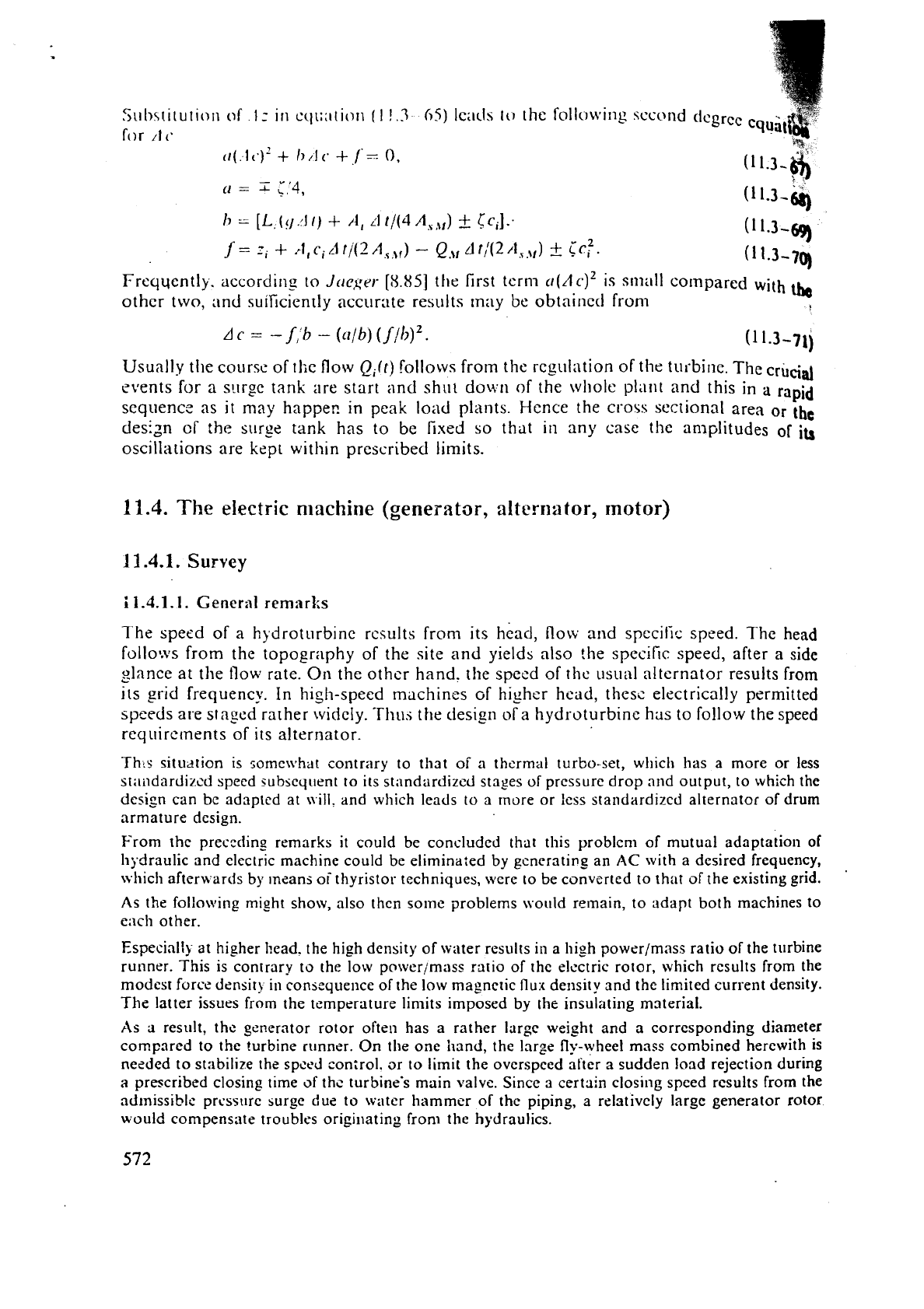
C
IIIUI
if
1
i
:;tii
I
!
3
65)
IC~IL~S
10
the follc)wi~lg sccond
dcgrce
egu
for
rl(.
tr(
1
c.)'
+
I)
/I
(-
+
/'=
0,
-
",
[J
=
A
5
4,
(1
1.3-@
h
L;
[L
((]/I
I)
+
/-I,
il
t/(4
A,,,,)
+
CC,]:
(1
1.3-9
f=~,+~1,~,nt/(2n,,,)-Q,,dr/(2/1,,,)+i~~.
(1
1-3-79
Frcqqently. accord~ng to
Jcre<i,r~r
[8.85]
tile
firs1
term
(~(Ac)~
is snlilll colnpared with
lb
other two, and su~ficiently accur:~te results rnny be obtained from
r
Usually tlie course of the flow
Qi(t)
follows from the
regulation
of the
tul-binc.
The
crucial
events for a surge tank
are
start and shut do\vn
of
the wllole p1311t
and
this in
a
rapid
scquence as
it
may
happer! in peak load plants. Hence the cross sectional area
or
design
cf
the
surge tank has to
be
fixed
so that in any case the amplitudes
of
ita
oscillations are kept within prescribed limits.
11.4.
The
electric
nlachitle
(generator,
alternator,
motor)
11.4.1. Survey
i
1.4.1.1.
General remarks
The specd
of
a hydroturbinc rcsults from its hcad, flow arid specitic speed.
The
head
follows from the topography of
the
site and yields also !he specific speed, after
a
side
glance at the
flow rate.
On
the
othcr hand. the speed of thc usual
alternator
results
from
its grid frequency. In high-speed machines of higher hcad, thes*: electrically permitted
speeds are
stayd rather widely.
Thus
ttie
tiesipn of a hydroturbine has to follow the speed
requirements
of
its
alternator.
Ths situdtion is somewhiit contrary to that of
a
thermal turbo-set, wllich has a more or less
standardized speed
subjcquent to its stnndardized stages of pressure drop and output, to which the
design can
be
adapted at will. and which leads to a more or less staridardizcd alternator of drum
armature design.
From
thc
preceding
remarks
it
could be concluded that this problem of mutual adaptation
of
11
jdraulic and clcctric machine could be eliminated by gcneratins an
AC
with
a
desired frequency,
\vliich afterwards by means oi thyristor techniques, were to be converted to that of the existing zrid.
As the followir~p misht show, also then sornc problems \vould remain, to adapt both machines to
e;lch other.
Especial!} at higher head. the high density of water results in a high power/mass ratio of the turbine
runner. This is contrary to the
low powerimass r2tio of the electric rotor, which results from the
modcsr force densit) in consequence of the low magnetic flux density and the limited current density.
The
latter issues from the temperature limits imposed by the insulating material.
As
n
result, thc gemrator rotor often has
a
rather large weight and
a
corresponding diameter
compared to
the ?urbine runner. On tlie
one
iiand, the large fly-wheel mass combined herewith is
necded to st;lbilize the speed ~onirol. or to limit the overspeed after
a
sudden load rejection during
a
prescribed closing time of the turbine's main valve. Since
a
certain closing speed results from the
adrnissiblc prcssurc surge due to water hammer of the piping, a relatively large generator rotor
would compensate troubles originating from the hydraulics.
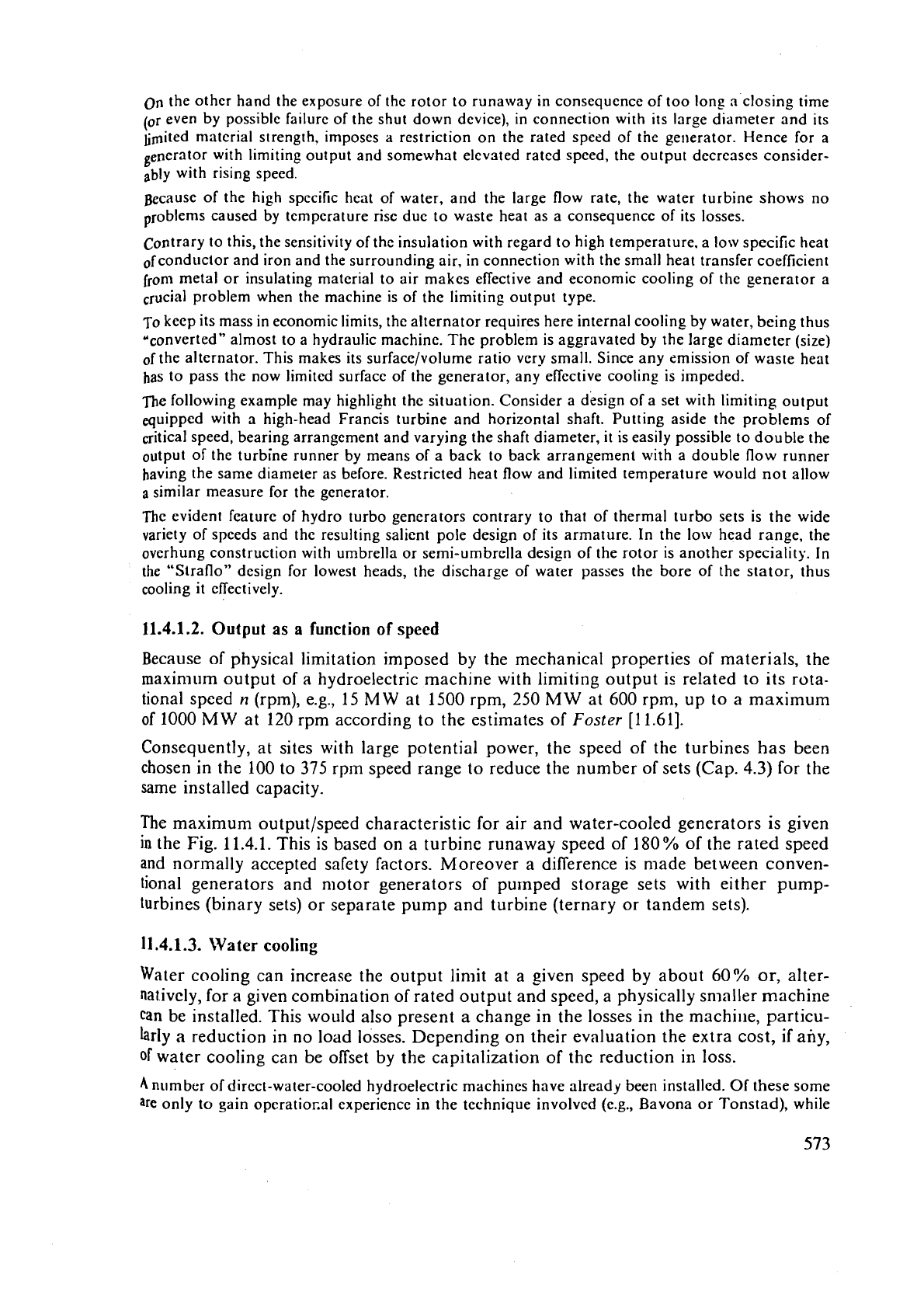
On the other hand the exposure of the rotor to runaway in consequence of too long
n
closing time
(or even by possible failure of the shut down device), in connection with its large diameter and its
limited
material strength, imposes
a
restriction on the rated speed of the generator. Hence for a
with limiting output and somewhat elevated rated speed, the output decreases consider-
ably with rising speed.
Because of the high specific heat of water, and the large flow rate, the water turbine shows no
problems caused by tcmpcrature rise due to waste heat as a consequence of its losses.
Contrary to this, the sensitivity of the insulation with regard to high temperature, a low specific heat
ofconductor and iron and the surrounding air, in connection with the small heat transfer coefficient
from metal or insulating material to air makes effective and economic cooling of
thc generator a
crucial problem when the machine is of the limiting output type.
To
keep its mass in economic limits, the alternator requires here internal cooling by water, being thus
'converted" almost to a hydraulic machine. The problem is aggravated by the large diameter (size)
of
the alternator. This makes its surface/volume ratio vcry small. Since any emission of waste heat
has to pass the now limited surface of the generator, any effective cooling is impeded.
fie following example may highlight the situation. Consider a d&n of a set with limiting output
equipped with
rt
high-head Francis turbine and horizontal shaft. Putting aside the problems of
critical speed, bearing arrangement and varying the shaft diameter, it is easily possible to double the
output of the turbine runner by means of a back to back arrangement with a double flow runner
having the same diameter as before. Restricted heat flow and limited temperature would not allow
a
similar measure for the generator.
The evident feature of hydro turbo generators contrary to that of thermal turbo sets is the wide
variety of speeds and the resulting salient pole design of its armature. In the low head range, the
overhung construction with umbrella or
semi-umbrclla design of the rotor is another speciality. In
the "Straflo" design for lowest heads, the discharge of water passes the bore of the stator, thus
cooling it effectively.
11.4.1.2.
Ouiput
as
a
function of
speed
Because of physical limitation imposed by the mechanical properties of materials, the
maximum output of a hydroelectric machine with limiting output is related to its rota-
tional speed
n
(rpm), e.g., 15
M
W
at 1500 rpm, 250 MW at 600 rpm, up to a maximum
of
1000 M
W
at 120 rpm according to the estimates of
Foster
[I 1.611.
Consequently, at sites with large potential power, the speed of the turbines has been
chosen in the 100 to
375
rpm speed range to reduce the number of sets (Cap.
4.3)
for the
same installed capacity.
The maximum
outputlspeed characteristic for air and water-cooled generators
is
given
in
the
Fig.
11.4.1. This is based on a turbine runaway speed of 180% of the rated speed
and
normally accepted safety factors. Moreover a difference is made between conven-
tional generators and
motor generators of pumped storage sets with either pump-
turbines (binary sets) or separate pump and turbine (ternary or tandem sets).
11.4.1.3.
Water
cooling
Water cooling can increase the output limit at a given speed by about 60% or, alter-
natively, for a given combination of rated output and speed, a physically smaller machine
can be installed. This would also present
a
change in the losses in the machine, particu-
larly a reduction in no load losses. Depending on their evaluation the extra cost, if any,
of
water cooling can be offset by the capitalization of the reduction in loss.
4
nlimber of direct-water-cooled hydroelectric machines have already been installed. Of these some
are only
to
gain operatiocal experience in the technique involved (e.g., Bavona or Tonstad), while

1.-ig.
1
1.4.1. Output
liniits
for
Ilydroclcsl~~ic gcnc.r;ltors bnscd
on
tllc nssunlption tllat !hc oversPced
r:~tio cclu:~ls 1.8. and the maxim
urn
stator
corc lcngth
equals
4
I
Lowcr
I-enn
(projected),
USSR;
4
6
Craig
Royston (projcctcd)
~1(.
3
Grntid Coulcc
USA;
4
~rasnoynrsk,
USSR;
5 Chl~rchi\\
Falls, Canllda;
7
Racoon Mountain,
USA;
S
Dinorwic, UK; 9 Horn-
bcrg, Gcrmnny; 10 Capljina,
Yugoslavia;
1
1
Dehar,
India;
12
Parabky-Zar, Poland; 13 and
14 Cruaclian, UK; 15 Tierfchd,
Switzerland;
16
Filisur, Switzer-
]and;
w
water-cooled;
x
niotot
generator;
o true generator.
nted
speed
others were built bccause, thc combination of speed and output are beyond the capacity of
an
air-cool:d machine, e.g., Wehr
(P
=
254 MW,
rr
=
600 rpn~), Krasnoyarsk
(P
=
507
MW,
'
n
=
107 rpm), Silz
(P
=
265
MW,
?I
=
500
rpm), Malta main stage
(P
=
208
IMW,
ir
=
500 rpm),
Itcipu
(P
=
730
hlW,
11
=
90.2 rpm or 93,2 rpm respectively).
.
11.4.1.4.
Pumped
storage motor-generators
The advent of
the
successful reversible Francis type pump-turbine has provided impetus
for some powerful sets.
In
these schemes the net head affects the choice of speed. The
mechanics1 design is eased because of the lower overspeed ratio,
namely
1,5
for
a
high
head pump-turbine compared with
1,8
for a Francis turbine. This originates from the
relatively smaller radial
extensior~ of
a
high head Francis turbine rotor.
The specific output per pole
11as reached about
35
MVA
per pole. Direct water cooling
will
further increase this value.
High
eficiency machines are required and there is the possibility of abnormal wear,
compared with conventional hydrogenerators, on all
conlponents due to their frequent
